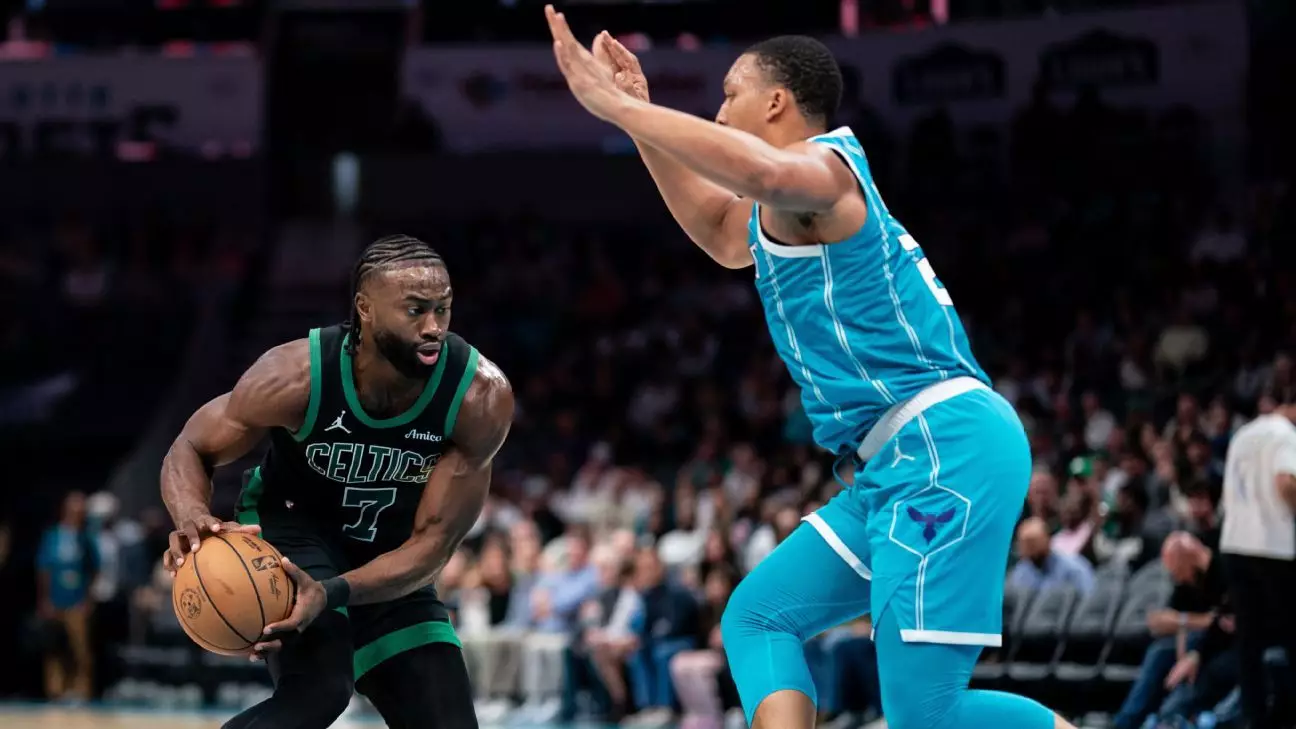The clash between the Boston Celtics and Charlotte Hornets on Friday night wasn’t just another game; it was a testament to the raw emotions and competitive spirit that permeate the NBA. Amidst the backdrop of a 124-109 victory for the Celtics, star guard Jaylen Brown emerged not only as a key player statistically but as a vocal figure in the aftermath of a controversial play involving his former teammate, Grant Williams. This incident sparked a flurry of reactions, highlighting the often turbulent nature of professional basketball relationships.
In the final moments of the game, the scene escalated when Williams collided with Jayson Tatum in a manner reminiscent of football rather than basketball. This pivotal moment culminated in Tatum tumbling to the floor, prompting an intense reaction from Brown. His immediate response was not merely instinctive defense of a teammate, but a deeper commentary on the guidelines governing sportsmanship within the league. “The foul was excessive,” he stated emphatically, dismissing the notion that it could have been a mere accident. This attitude exemplified the protective mentality that typifies athletes who feel a strong bond with their teammates.
Brown’s words carried weight, as they reflected a sentiment shared by many athletes who seek not only to protect their own but also to uphold the integrity of the game. His description of the foul as reminiscent of a “football play” succinctly captured the gravity of the situation. Brown articulated a larger narrative, questioning the ethics of Williams’s actions—a player he had shared both friendship and team dynamics with for several years. “I thought JT and Grant were friends. … I guess not,” he remarked, highlighting the often fragile nature of camaraderie in a competitive environment.
Following the incident, Williams defended his actions by asserting that there was no malicious intent behind the foul. His remark, “Not trying to hurt anybody,” pointed to a common issue in sports where the physicality of the game sometimes blurs the lines between aggression and danger. However, it also raised questions about responsibility among players who must navigate their relationships on the court while competing fiercely against each other.
Tatum’s quietude after the incident provided another layer of complexity to the situation. While he garnered attention for his impressive performance—scoring a game-high 32 points—his refusal to engage with the media post-game suggested a restrained emotion, possibly reflecting on both the game’s physicality and his relationship with Williams. Tatum’s resilience, underscored by his rapid recovery from the fall, exemplified his focus on the game rather than interpersonal drama.
Celtics head coach Joe Mazzulla also sought to diffuse tensions. By refusing to condemn Williams outright, he steered the discussion away from personal conflicts and back toward team-focused growth. Mazzulla’s commentary, emphasizing Tatum’s readiness to move on and perform, underscored a critical aspect of the sport—a team must maintain focus, despite the distractions that arise from rivalries and conflicts.
The increasing physicality in the game, illustrated by both Williams’s flagrant foul and LaMelo Ball’s subsequent dangerous play, suggests a wider tendency within the league—teams often resorting to hard fouls as a strategy to assert dominance and provoke retaliation. Brown’s succinct commentary on the actions taken by opposing teams encapsulates a growing trend in the NBA where aggression is sometimes mistaken for competitive spirit. His statement, “we’re not going for none of that,” exemplified the resolve of the Celtics to remain unyielded by such tactics.
As the two teams prepare for a rematch, the stakes are elevated. The anticipation for the upcoming game in Boston is tinged with simmering tensions and expected retribution. Rivalries in sports are often shaped by moments like these—when camaraderie is tested by fierce competition, and the essence of teamwork is scrutinized under the harsh light of conflict.
The encounter left the Celtics and Hornets with more than just a scoreline; it cast a spotlight on the intricate relationships and rivalries that define the ongoing narrative of the NBA. In the world of professional basketball, the interplay of friendship and competition continues to inspire dialogue both on and off the court.


Leave a Reply